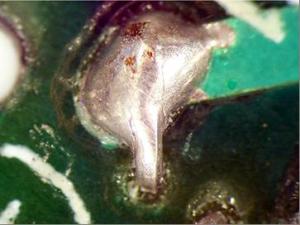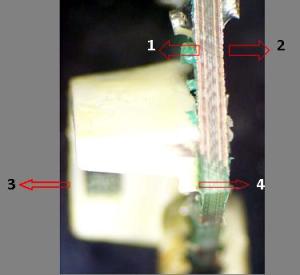Solder Joint Strain Failures
Gideon Analytical Laboratories performed failure analysis on two printed circuit board assemblies (PCB) with fractured solder joints on the Hall Sensor interconnect. The assemblies were taken apart and the conformal coating was removed to reveal the solder joints of the Hall Sensor. Five out of six of the Hall Sensors were mounted flush against the Valox 457 mounting block.
A Hall Effect Device detects magnetic flux density and is used in both movement and position sensing. By integrating the sensing element onto the same silicon as its control logic and interface circuitry, Melexis, a maker of Hall Sensors has produced sensor chips with different degrees of intelligence to suit a vast array of applications, a pioneer in linear, programmable Hall Effect sensors, accurate rotary,and linear position indication. Incorporating memory and simple hood, safety,and drive-by-wire applications. Whether sensing actuator, pedal, throttle and steering wheel position, the rotation of camshafts or crankshafts in an engine or monitoring movement in motors, Hall devices offer a reliable, contactless method of movement and position detection.
The crack, as with all cracks observed on the joints, is initiating from the side near to the hole. This is visible in the picture at the top left. It is clear the PCB solder joints are fracturing. A cross section of the PCB with the Valox 457 standoff block reveals what is occurring. The arrows indicate the direction of movement that will occur when the materials undergo thermal expansion. The arrows go in the opposite direction when the heat is removed.
It was found the Valox 457 will move 5 times the more than the PCB for a given temperature range. Since the interface arrows of the Valox to PCB are in opposite directions (1&4), they will not move and these opposing forces will translate into further expansion (or strain as the case may be) between the arrows 3 and 2. This causes a strain problem in the solder joints of the Hall Sensor. The final conclusion was that the strain on the Hall Sensor leads must be eliminated to stop the solder fractures. Moving the Hall Sensors to the other side on the PCB would eliminate this failure mechanism.
Failure analysis provided by Gideon Analytical Laboratories can provide invaluable information to a variety of companies in the electronics field. Results from failure analysis testing can help companies streamline and eliminate problems in production with quick implementation of corrective action. Accurate and candid failure analysis results can also help companies negotiate the business world with more certainty.

Solder joint cracks

Direction of thermal movement